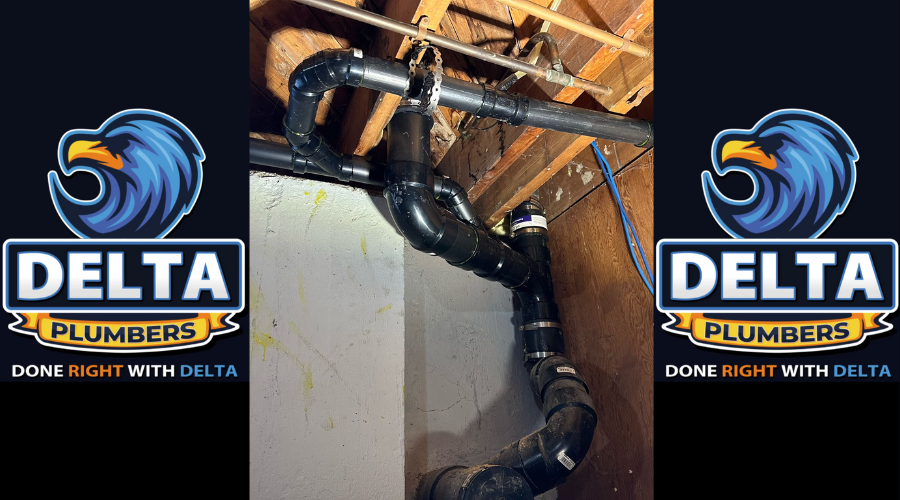Plumbing issues are often among the most stressful and costly problems a homeowner can face. Within your plumbing system, drain pipes play an essential role by safely carrying wastewater away from your home. If these pipes become damaged or fail, the consequences can be severe, including extensive water damage, structural issues, expensive repairs, and significant disruptions to your daily life. That’s why it’s crucial to recognize early warning signs of drain pipe failure and take timely action. In this detailed guide, we’ll walk you through everything you need to know: how to tell if you need a drain pipe replacement or a deteriorating drain pipe, common causes of pipe damage, and how to evaluate whether repair or complete replacement is the better long-term solution for your home’s plumbing health.

Picture Source – Delta Plumbers
Common Signs You Need a Drain Pipe Replacement
Recognizing the early signs of a broken drain pipe can prevent serious issues. Here are the most common indicators:
Slow Draining Sinks and Bathtubs
If your sinks or bathtubs take longer than usual to drain, it could be a sign of a blocked drain pipe or even deeper issues such as collapsed piping. This often happens when debris accumulates over time, but persistent problems suggest a more serious underlying issue.
Frequent Drain Clogs
Occasional clogs are normal, but if you experience frequent blockages, especially in multiple fixtures, it may point to a broken sewer line or damaged drain pipe. Chronic clogs indicate that the issue is not localized and could stem from significant damage.
Unpleasant Odors
A persistent foul smell from drains could indicate a cracked or leaking drain pipe, allowing sewer gases to escape. This is not just unpleasant; it can also pose serious health risks to occupants.
Wet Spots and Water Damage
Unexplained wet spots on floors, ceilings, or walls are often a result of leaking pipes hidden behind structures. Water damage can quickly escalate, leading to mould growth and structural damage if left unaddressed.
Mould and Mildew Growth
Moist environments encourage mold growth. If you notice unusual mould patches, it might be time to check your underground drain pipes for damage. Mould can cause respiratory issues and weaken the structural integrity of your home.
Sewer Backups
Sewage backup in toilets or drains is a clear sign that you may need a sewer line replacement. Sewer backups can cause significant property damage and pose serious health risks, making immediate attention crucial.
Unusual Lawn Changes
A sudden lush patch of grass or soggy areas in your yard could indicate a leaking underground drain pipe. Excess water from a broken pipe can cause parts of your lawn to grow faster and greener than others.
Also Read: Bathroom Plumbing Upgrades That Add Real Value to Your Home

Picture Source – Delta Plumbers
Causes of Drain Pipe Damage
Understanding what causes damage can help you prevent future issues and decide if a drain pipe repair or replacement is needed.
Aging Pipes
Drain pipes, especially those made from materials like cast iron or clay, deteriorate over time, leading to cracks and collapses. Older homes are particularly susceptible to aging pipe systems that require eventual replacement.
Tree Root Intrusion
Roots can penetrate small cracks in pipes and expand, causing major blockages and structural failure. Trees naturally seek moisture, and your drain pipes provide an ideal source.
Soil Shifts
Heavy rains, droughts, or construction work can shift the soil around pipes, causing them to crack or break. Soil movement can exert pressure on pipes, leading to fractures and misalignments.
Poor Installation
Incorrect slope, low-quality materials, or rushed installations often lead to early pipe failure. Pipes that are not installed properly may be prone to constant issues and need early replacement.
Corrosion
Pipes made of metal can corrode over time due to chemical reactions with water and soil, necessitating a complete replacement. Corrosion weakens pipes from the inside out, often going unnoticed until a major issue arises.
Chemical Damage
Pouring harsh chemicals down the drain can erode pipes from the inside, causing leaks and failures. Regular use of chemical cleaners can accelerate the degradation of your plumbing system.
Also Read: Prepare Your Plumbing for Ontario’s Summer Storms

Picture Source – Delta Plumbers
How to Confirm If You Need a Drain Pipe Replacement
Sometimes the symptoms are clear, but other times a professional evaluation is necessary. Here’s how experts confirm the need for a drain pipe replacement:
Camera Inspection
Plumbers use specialized cameras to inspect the interior of your drain pipes for cracks, collapses, and blockages. This non-invasive method provides a clear visual of pipe conditions.
Pressure Testing
Pressure tests can detect leaks in the drain and sewer lines by measuring pressure drops. A sudden pressure drop often signals the presence of a leak.
Dye Testing
Adding a safe dye to the water system can reveal hidden leaks when colored water appears in unexpected places. This simple yet effective method helps pinpoint leak locations.
Listening Devices
Acoustic equipment can detect the sound of leaks underground or behind walls. Specialized tools amplify the noise of water escaping from pipes, helping locate the source precisely.
Hiring a licensed plumber for these inspections ensures accurate diagnosis and helps you understand the cost to replace drain pipes if necessary.
Also Read: Maintain Your Home’s Sewer Line and Avoid Costly Repairs: How to Do It

Picture Source – Delta Plumbers
Repair vs Replace: Making the Right Decision
Once the problem is diagnosed, the next step is deciding between repair and replacement.
When to Repair
Minor cracks or isolated clogs often require simple repairs. If the pipe material is still structurally sound and the damage is confined to a small section, a targeted repair can restore full functionality.
When to Replace
Pipes over 50 years old, severe corrosion, extensive tree root damage, multiple cracks, or frequent, costly repairs usually signal the need for full replacement. Investing in a new pipe system can save money in the long run and prevent recurring issues.
Consulting a professional plumber helps in weighing the benefits of underground drain pipe repair versus complete replacement.
Also Read: Professional Faucet Repair is Better Than DIY Solutions: Why?

Picture Source – Delta Plumbers
Cost to Replace Drain Pipes
Understanding the financial aspect helps you prepare for the investment.
Factors Affecting Cost
- Pipe Material: PVC is cheaper, while cast iron is more expensive but more durable.
- Pipe Location: Pipes under slabs or deep underground cost more to access and replace.
- Extent of Damage: Extensive damage requires more labour and materials.
- Permits and Inspections: Required by local codes, adding to the overall expense.
Average Costs in Ontario
- Simple Replacement: $300 – $800
- Major Drain Line Replacement: $3,000 – $7,000
- Sewer Line Replacement: $5,000 – $12,000
Always get multiple quotes from reputable plumbing companies to ensure fair pricing and quality service.
Also Read: Top 7 Summer Plumbing Issues and How to Prevent Them

Picture Source – Delta Plumbers
How to Choose the Right Plumber for Drain Pipe Replacement
Choosing the right plumber can make a big difference in quality and cost.
Check Credentials
Ensure the plumber is licensed, insured, and certified for drain pipe replacement and sewer line services.
Ask for References
Request references or read online reviews to gauge customer satisfaction levels.
Evaluate Communication
A good plumber explains issues clearly, answers questions patiently, and provides transparent pricing.
Get Written Estimates
Detailed, written estimates prevent misunderstandings and ensure you are aware of all charges upfront.
Choosing a local, trusted company like Delta Plumbers ensures your project is handled with professionalism and care, giving you peace of mind throughout the process.
Also Read: Eco-Friendly Plumbing Upgrades Every Homeowner Should Know in 2025

Picture Source – Delta Plumbers
Preventing Future Drain Pipe Problems
After your drain pipes are repaired or replaced, take steps to prevent future issues.
Regular Inspections
Schedule annual or bi-annual inspections to identify minor problems before they escalate into major repairs.
Avoid Chemical Drain Cleaners
Opt for enzyme-based or natural drain cleaning solutions that won’t corrode your pipes over time.
Mind What You Flush
Only flush human waste and toilet paper. Items like wipes, feminine hygiene products, and paper towels can cause blockages.
Install Root Barriers
Installing root barriers can prevent tree roots from infiltrating your pipes, a major cause of underground drain pipe damage.
Upgrade Old Pipes
If your home has outdated plumbing materials, plan a phased upgrade to modern, durable piping materials like PVC or PEX.
Maintaining your plumbing system keeps your home safe, your water flowing freely, and your costs down.
Conclusion –
Knowing how to tell if you need a drain pipe replacement can protect you from major headaches and expensive damage. Watch for early signs like slow drains, bad odors, and sewer backups. If you notice any of these symptoms, consult a licensed plumber immediately. Whether it’s underground drain pipe repair or a complete replacement, timely action will safeguard your home.
At Delta Plumbers, we specialize in fast, professional, and reliable drain pipe replacement and sewer line services across Ontario. Trust our experienced team to keep your plumbing system in top shape!
Contact Delta Plumbers today for a professional drain pipe inspection and replacement consultation. Your peace of mind is just a call away!









